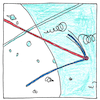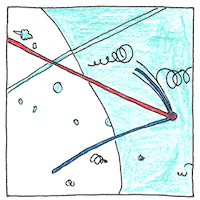Wolfgang Pauli, Frederick Reines, Clyde Cowan
physics

|
Neutrino
In the thirties Wolfgang Pauli kept insisting there could be a particle without an electric charge. Pauli called it a neutron but Fermi renamed it after Chadwick discovered neutrons in the nucleus of an atom. Assuming that energy is conserved, neutrinos were needed to explain energy lost during beta decay. So Reines and Cowan set up detectors near a nuclear reactor and found characteristic cascading events triggered by neutrinos hitting protons in water molecules.
Oscillating mass
Neutrinos either travel at the speed of light or they have a mass, however small. If they have mass, they could acquire it according to the Majorana mechanism, which would mean they are their own antiparticles. Multiple experiments have shown neutrinos traveling near the speed of light. However, they are known to have mass because we can observe them oscillate between flavors— electron neutrino, muon neutrino, tau neutrino.
Elusive goal
Six quarks and six leptons suggests there might be exactly three neutrino flavors although a fourth the sterile neutrino could exist.
Theory of light
Louis de Broglie suggested a photon might be a combination of a neutrino and an antineutrino but the standard theory holds that the photon is not a composite particle. Different problems exist with each possibility but the theory of neutrino-antineutrino transitions underlies the theory of flavor oscillation, which has been observed.



Sixty-five billion neutrinos from the sun pass through every square centimeter on Earth every second. Boing! They could be hitting many of your protons! Although neutrinos have no electric charge, they interact with other particles by the weak nuclear force. Neutrinos are fermions, along with protons, neutrons, electrons, and quarks.
See also in The book of science:
Readings in wikipedia: